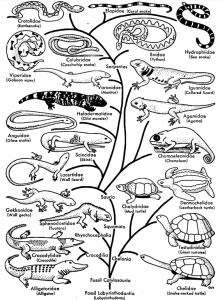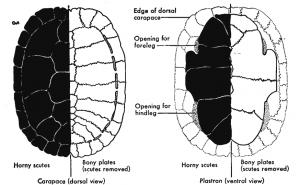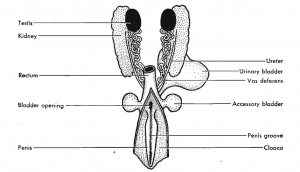Contents:
Class Reptilia- Turtles
- The reptiles constitute one of the most interesting, and, in general, one of the least known classes of the vertebrates. They are cold-blooded; usually covered with scales, and, frequently, with bony plates; and they always breathe by lungs.
- The popular notion that reptiles are slimy is erroneous. Contrary also to general belief, very few reptiles, at least those in the United States, are dangerous to man; the majority are harmless, and many are even beneficial.
- The reptiles living today are but a fraction of the vast hordes that inhabited the earth’s Surface in prehistoric times. In fact, of the approximately 16 orders of reptiles now recognized by herpetologists, only 4 possess living representatives, and one of these includes a nearly exterminated species confined to New Zealand.
- The 4 orders of living reptiles are as follows:
- Order 1. Chelonia (Testudinata). Turtles and tortoises.
- Order 2; Rhynchocephalia. Sphenodon, a lizardlike reptile confined to New Zealand.
- Order 3. Squamata. Lizards, and snakes.
- Order 4. Crocodilia. Crocodiles, alligators, gavials, and caimans.
The reptiles are better adapted for living on land than amphibians. Some of the advances shown by reptiles over amphibians are:
(1) a dry scaly skin which is an adaptation for a complete existence on land,
(2) limbs better suited for rapid locomotion,
(3)partial or complete separation of the ventricle resulting in further separation of the oxygenated and nonoxygcnated blood in the heart
(4) well-ossified skeleton,
(5) Some form of copulatory organ which is necessary for internal fertilization
(6) eggs with shells suited for development on land and protective embryonic membranes to prevent drying, another adaption for life on land.
- Reptiles are most abundant in the warmer regions of the world; very few live in the colder parts of the temperate zone, and none in the Arctic or Antarctic regions.
- Nevertheless, the United States is well supplied with both species and individuals. About 243 species of all the reptiles that have been described are known to occur in this country.
- Reptiles occupy an important place in the vertebrate series because their anatomy is intermediate between that of a typical amphibian on the one hand and that of a typical bird on the other.
- Comparison of the structure and physiology of reptiles with. The poisonous nature of certain reptiles, the enormous size of some of the prehistoric species, and the relations of reptiles to man are among the most interesting general features of the class.

TURTLE
The turtle has been selected as a representative reptile. The body is so constructed that it is adapted to live either in the water or on land. Although it is slow-moving on land, it can swim quite rapidly.
External features
- The turtle is distinguished from all other animals by the shell which is’ broad and flattened and protects the vital organs.
- Even the head, limbs, and tail can be more or less completely withdrawn into the shell. The neck is long and very flexible; the head is flattened dorsoventrally. The mouth is large, but instead of teeth, horny plates form the margin of the jaws; they are used to crush their food.
- The external nares (nostrils) are placed together, near the anterior end of the snout. The eyes, situated one on each side of the head, are each guarded by three eyelids:
- A short, thick, opaque upper lid;
- A longer, thin lower lid; and
- A transparent nictitating membrane, which moves over the eyeball from the anterior comer of the eye. Just behind the angle of the jaw on either side is a thin tympanic membrane.
- The limbs usually possess 5 digits each; most of the digits are armed with large horny claws that are useful in crawling, climbing, or digging. The skin is thin and smooth on the head, but thick, tough, scaly, and much wrinkled over the exposed parts of the body.
Skeleton
- Since the life of the turtle is influenced so strongly by the skeleton, this system will be briefly described first.
- The shell consists of a convex dorsal armor, the carapace, and a flattened ventral armor, the plastron; these are strongly’bound together on each side by bony bridges varying in width with the species.
- Both carapace and plastron are usually covered by a number of symmetrically arranged horny plates, called scutes (shields); the scutes do not correspond either in number or arrangement to the bony plates beneath them.
- The number and shape of the scutes vary according to the species but are usually constant ih individuals of the same species.
- The horny scutes of the hawksbill turtle furnish the tortoiseshell of commerce. Beneath the scutes are a number of bony plates formed by the dermis and closely united by sutures.
- The vertebrae and ribs are usually consolidated with the bony carapace; no sternum is found in these forms. Soft-shelled turtles have a leathery shell which is not divided into scutes, and it contains little bony substance.
Digestive system
- Turtles feed on both plants and animals; some are entirely vegetarian. The animals preyed upon are waterfowl, small mammals, and many kinds of invertebrates.
- The flexible neck enables the turtle to rest on the bottom and reach out in all directions for food. The jaws of large snapping turtles are powerful enough to amputate a finger or even a hand.
- The digestive organs are simple. The broad soft tongue is attached to the floor of the mouth cavity; it is not protrusible.
- The two posterior nares are situated in the anterior part of the roof of the mouth. At” the base of the tongue is a longitudinal slit, the glottis, and a short distance back of the angle of the jaw are the openings of the Eustachian tubes.
- The pharynx is thin walled and very distensible; it leads into the more slender and thick-walled esophagus.
- The stomach opens by a pyloric valve into the small intestine; this is separated from the large intestine by · the ileocecal valve.
- The terminal portion of the digestive canal is the rectum; it opens into the cloaca. There is no intestinal cecum. The liver discharges bile into the intestine through the bile duct. Several pancreatic ducts lead from the pancreas to the intestine .

Circulatory system
- The reptilian heart , except in the case of the Crocodilia. consists of two atria and a single ventricle which is divided into two by an incomplete septum.
- In the crocodilians the longitudinal septum in the ventricle is complete, forming a 4-chambered heart. The venous blood from the body is carried by the posterior vena cava and the two anterior venae cavae into the sinus venosus and thence into the right atrium.
- From here it passes into the right side of the ventricle, and when the latter contracts, it is forced out through the pulmonary artery which sends a branch to each lung and through the left aorta which conveys blood to the viscera, and into the dorsal aorta.
- The blood which is oxygenated in the lungs is returned by the pulmonary veins to the left atrium and thence into the left side of the ventricle.
- This blood is pumped out through the right aortic arch, which merges into the dorsal aorta. Because the septum dividing the ventricle into two is incomplete, the blood that enters the right aortic arch is a mixture of oxygenated blood from the left atrium and venous blood from the right atrium.
- Certain species of turtles have a well-developed renal portal system; the hepatic portal system shows an advance in development over the condition as described in the frog.

Respiratory system
- Turtles breathe by means of lungs. Air enters the mouth cavity by way of the nasal passages. The glottis opens into the larynx, through which the air passes into the trachea or windpipe. The trachea divides, sending one bronchus to each lung.
- The lungs are more complicated than those of the amphibians. The bronchi branch out a number of times, and the lung cavity is broken up into many spaces so that the respiratory surface is greatly increased.
- The presence of a hard rigid shell, in turtles, makes general expansion and contraction of the body impossible.
- Turtle respiration, therefore, presents some unusual problems. It was formerly thought that it had a breathing mechanism similar to amphibians, but this is not the case; the turtle has its own unique method of breathing.
- Inspiration is accomplished by two flank muscles which serve the same function as the mammalian diaphragm: to enlarge the coelom and cause air to be “sucked” into the lungs.
- To accomplish expiration, the turtle uses paired expiratory muscles which enclose the viscera. Air is forced out of the lungs by the contraction of the expiratory muscles which press the viscera against the lungs. This action is assisted by pulling in the legs and neck, which further decreases the size of the body cavity.
- Many aquatic turtles probably carryon respiration to some extent by taking water into the cloaca and the accessory bladders and then forcing it out through the local opening.
- Thus these structures may serVe as supplementary respiratory organs (compare with sea cucumber, and nymph to dragonfly). It has also been sugested that in the aquatic forms certain areas of the skin may be modified for respiration.
Urogenital system
- Excretion is carried on by the two kidneys. Their secretions pass through the ureters into the cloaca, are stored in the urinary bladder, and then make their exit through the clocal opening.
- This is often called the anus, but the anus properly refers to the opening of the digestive tract; therefore, in those forms with a cloaca, this term should apply to the opening of the intestine into the cloaca.
- The sexes are separate. The male organs are a pair of testes and a pair of vasa deferentia through which the sperms pass to the grooved copulatory organ or erectile penis attached to the ventral wall of the cloaca; It should be noted that the reptiles are the first vertebrates in which there is a penis.
- The female organs are a pair of ovaries and a pair of oviducts; the latter open into the cloaca. The sperms are injected into the female by a sexual act ( copulation), usually preceded by courtship behavior.
- Turtles are oviparous. The eggs which are white, round or oval, and covered by a more or less hardened shell, are laid in the holes dug by the female, m soil or decaying vegetation, in which heat aids in incubation.

Nervous system
The brain is more highly developed than in the amphibians. The cerebral hemispheres are larger, and a distinction can be made between the superficial gray layer and the central white medulla. The cerebellum is also larger, indicating an increase in the power of coordinating movements. There are 12 pairs of cranial nerves.
Sense organs
The eye is small. It has a round pupil and an iris which is usually dark in terrestrial forms but often coloured in aquatic turtles. The sense of hearing is not well developed, but the turtle responds readily to vibrations
Painted turtle through the skin, so it is easily frightened by noises. The sense of smell enables the turtle to distinguish between various kinds of food both in and out of the water. The skin over many parts of the body is very sensitive to touch.
References
- MODERN TEXT BOOK OF ZOOLOGY: VERTEBRATES R.L. KOTPAL
- https://www.ncbi.nlm.nih.gov/pmc/articles/PMC3609858/
- https://www.ncbi.nlm.nih.gov/pmc/articles/PMC4406946/